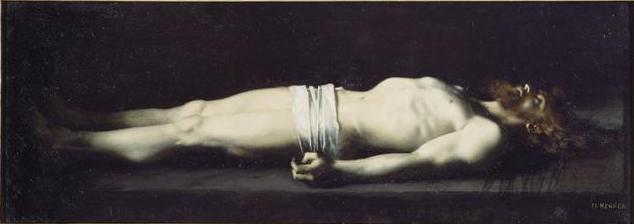
Holy Saturday is a rather quiet day during Holy Week leading up to the celebration of Easter. Jesus done a lot between Palm Sunday and Good Friday. His death on that day was that of an ordinary criminal which was not a nice, quiet death at all; sometimes it took many hours or even a day or two. In Jesus's case, it took about six hours. The body was taken down from the cross and laid in a tomb which was then sealed. On Holy Saturday we wait, outside the door to the tomb.
Holy Saturday is the holding period for us. We decorate the church for the Easter celebration and, for many congregations, a celebration of the Easter vigil on holy Saturday evening. It is a retelling of salvation history and leading up to the events of the resurrection. It is a happy joyous service, but first comes the quiet preparation and before that simply the quiet.
We seldom think about the time between Jesus being taken down from the cross and put in the tomb and the vision of the empty tomb on the announcement of Jesus resurrection. In Scripture that's a blank space. Nothing. How did the disciples spend the time other than hunkered down, hoping that they would not be caught and recognized as followers of Jesus, or simply tried to go about daily life which didn't stop just because Jesus has died?
This image, by Jean-Jacques Henner, shows Jesus in a posture of repose but not swaddled in burial shrouds. It shows him all alone, without any company-- no angels, no grieving family, and pictured against a dark background. We seldom think about Jesus that way, but maybe we should.
Jesus was the son of God; that is one belief we Christians have in common. But besides being the son of God, Jesus was also a human being. His conception was a bit extraordinary, but he was born, lived, and died as a human being. Had he simply been in the middle of his ministry and then suddenly be lifted up to heaven, that might have given rise to some speculation. Jesus came to earth as a human being, a child with skinned knees, a young man leaving the family to pursue a powerful calling, preaching and teaching and healing in all sorts of places and involving all sorts of people. The one thing we don't like to think about is that in order to live a fully human life, Jesus also had to die as a human being.
All humans are born, live their lives, then die. Jesus's stay in the tomb only lasted from the Friday afternoon until when? Was he in the tomb when he visited hell, an event which we call the Harrowing of Hades? Or was he able to be in two places at once? We aren't sure precisely when that resurrection took place other than that Mary, Jesus's mother and her companions --or, per another gospel, Mary Magdalene was there alone--went as early as possible after the Sabbath to anoint him. They had not had time to do so immediately after his crucifixion. But the tomb was empty.
We very easily picture the empty tomb, but not so often the occupied one containing the body of the man called Jesus. We forget that Jesus was human, and we forget that at this time he lay on a bed of stone wrapped in linen and totally alone. It's entirely possible that God sent angels to keep him company, or that the resurrection happened within hours after the tomb was sealed. We simply don't know and will never really know, but one thing we need to consider is that in order to live a full human life, Jesus had to experience death.
He had to experience lying in the tomb had to undergo the same sort of mortal process of death and dying that all human beings have to undergo. None of us like to picture death, much less what's going on in the coffin once it sealed and laid in the ground. Perhaps we needn't think about it at this particular time in the church year either, but the point that I took coming back to is that Jesus, like us, was alone in death, and alone for a time, at least, in the tomb.
Somehow it's comforting to know that the Savior of the world knew what humanity truly felt like because he had experienced it from beginning to end. At his death, Jesus knew total separation from God. Many feel that way in life and also when life is ending. For us it is an illusion because God never leaves us alone and in the darkness, but Jesus, having experienced it, did not want us to be left in that place of emptiness and despair.
So, on this Holy Saturday, I contemplate mortality and death, but I also hope for the resurrection and joining God in heaven just as Jesus did. Instead of focusing on dyeing Easter Eggs or doing the church flowers, I will be thinking about Jesus knowing true separation from God so that he could bring us all closer to God.
It's a pretty powerful thing to think about on this holy Saturday.
Image: Jesus at the Tomb by Jean-Jacques Henner, 1879 (public domain via Wikimedia Commons)
Originally published at Speaking to the Soul on Episcopal Café Saturday, March 25, 2016.
No comments:
Post a Comment